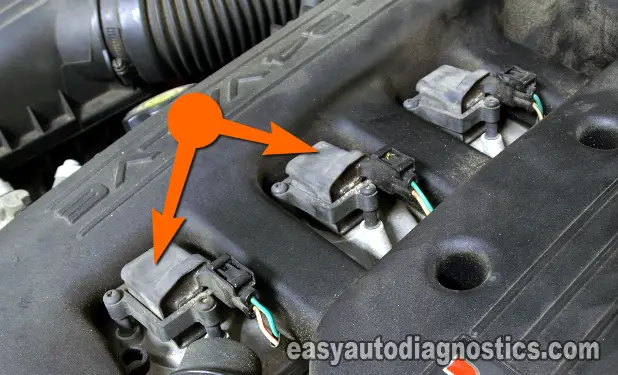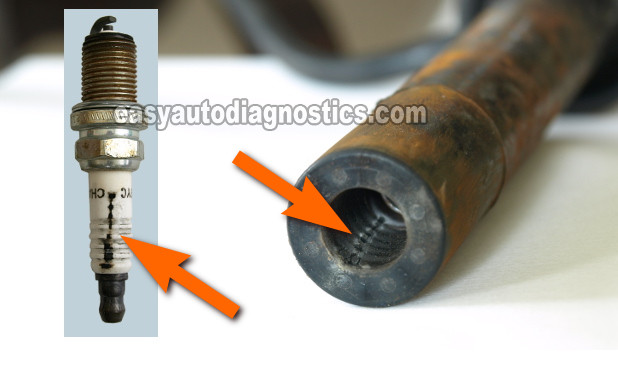TEST 4: Testing The Trigger Signal (2nd Method)

Testing for the Switching Signal can be done indirectly on this type of Coil-On-Plug ignition system.
This is done by taking an ignition coil that did spark in TEST 1 and plugging it into the connector of the one that did not spark.
Here are the specifics of this test:
- 1
Disconnect the ignition coil that did not spark from its connector, remove it from its spot on the engine and set aside somewhere.
- 2
Remove one of the nearby ignition coils (that did fire spark in TEST 1).
- 3
Connect the ignition coil to the connector of the ignition coil that did not spark.
- 4
Connect the HEI spark tester to the ignition coil.
- 5
Have your helper crank the engine while you observe the spark tester.
NOTE: Be careful, the engine may start. - 6
The spark tester should spark.
OK, as you can see/read, you're verifying the presence of the Triggering Signal by a process of elimination (of sorts). Here are the test result interpretations:
CASE 1: You got spark. This is the correct test result and you can conclude that the Triggering Signal is present. This result indicates that the Coil-On-Plug ignition coil on your GM vehicle (pick up truck, SUV, or van) is bad and needs to be replaced.
CASE 2: You got NO spark. Re-check all of your connections and repeat the test again. If still no spark, then this results eliminates the ignition coil as the source of the no-spark condition/misfire, since without the Triggering Signal the COP ignition coil will not work.
TEST 5: Carbon Tracks And Other Stuff

You've reached this test step because there's a good possibility that the misfire, that your Chrysler (or Dodge or Plymouth) vehicle is experiencing, isn't due to a bad Coil-On-Plug ignition coil. This section will delve into other possible causes.
One of them is carbon tracks. Carbon tracks are one of the leading causes of misfires. This condition usually occurs on vehicles that have over 100,000 miles on them and is a result of lack of maintenance (since the spark plugs and spark plug wires should have been replaced at this mileage or before). Of course the spark plugs and spark plug wires should perform flawlessly for one hundred thousand miles (100,000) theoretically speaking (I never learned to speak Theoretical). But this doesn't really happen in real life.
So, to make the long story short (you're probably already getting eye-strain from reading this article), you should check for carbon tracks on the spark plug wires and the spark plugs. In the photo above, you'll see what they look like. Below are other suggestions to look into:
- Valve cover gaskets leaking oil into the spark plug wells (tubes).
- The 3.2L and 3.5L engines are notorious for this. If the spark plugs and the ignition coil boots are soaked in engine oil, you'll have to replace the Valve cover gaskets on both cylinder Heads and replace all spark plugs and ignition coil boots (otherwise, if you reuse the spark plugs and boots, carbon tracks will soon form and you'll have a misfire on your hands again).
- Low engine cylinder compression in one or more cylinders.
- Bad fuel injectors.
- Leaking intake manifold gasket.
- Fuel pressure regulator gone bad and leaking fuel into its vacuum hose.

If this info saved the day, buy me a beer!

